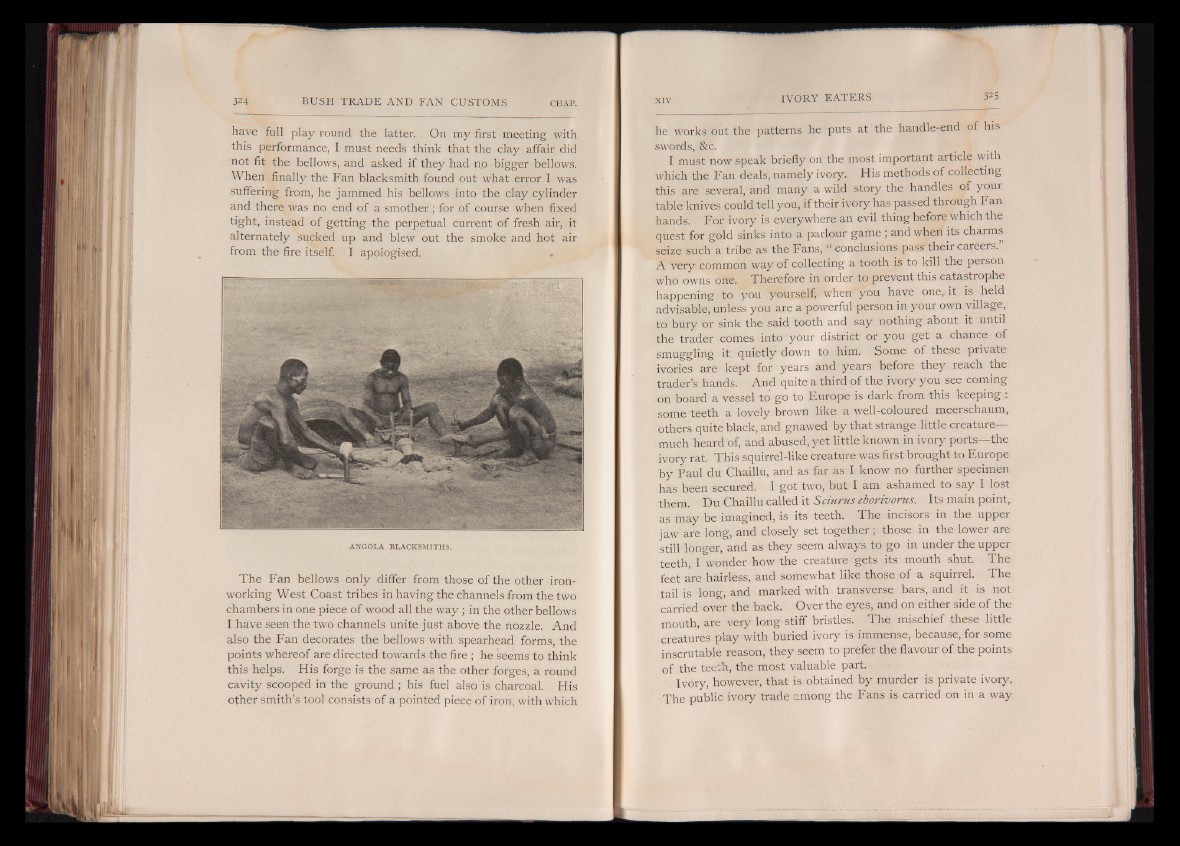
have full play round the latter. On my first meeting with
this performance, I must needs think that the clay affair did
not fit the bellows, and asked if they had n.o bigger bellows.
When finally the Fan blacksmith found out what error I was
suffering from, he jammed his bellows into the clay cylinder
and there was no end of a smother; for of course when fixed
tight, instead of getting the perpetual current of fresh air, it
alternately sucked up and blew out the smoke and hot air
from the fire itself. I apologised. .
ANGOLA BLACKSMITHS.
The Fan bellows only differ from those of the other iron-
working West Coast tribes in having the channels from the two
chambers in one piece of wood all the w a y ; in the other bellows
I have seen the two channels unite just above the nozzle. And
also the Fan decorates the bellows with spearhead forms, the
points whereof are directed towards the fire; he seems to think
this helps. His forge is the same as the other forges, a round
cavity scooped in the ground ; his fuel also is charcoal. His
other smith’s tool consists of a pointed piece of iron, with which
he works out the patterns he puts at the handle-end of his
swords, &c.
I must now speak briefly on the most important article with
which the Fan deals, namely ivory. His methods of collecting
this are several, and many a wild story the handles of your
table knives could tell you, if their ivory has passed through Fan
hands. For ivory is everywhere an evil thing before which the
quest for gold sinks into a parlour game ; and when its charms
seize such a tribe as the Fans, “ conclusions pass their careers.”
A very common way of collecting a tooth is to kill the person
who owns one. Therefore in order to prevent this catastrophe
happening to you yourself, when you have one,-it is held
advisable, unless you are a powerful person in your own village,
to bury or sink the said tooth and say nothing about it until
the trader comes into your district or you get a chance of
smuggling it. quietly down to him. Some of these private
ivories are kept for years and years before they reach the
trader’s hands. And quite a third of the ivory you see coming
on board a vessel to go to Europe is dark from this keeping :
some teeth a lovely brown like a well-coloured meerschaum,
others quite black, and gnawed by that strange little creature-
much heard of, and abused, yet little known in ivory ports— the
ivory rat. This squirrel-like creature was first brought to Europe
by Paul du Chaillu, and as far as I know no further specimen
has been secured. I got two, but I am ashamed to say I lost
them. Du Chaillu called it Sciurus eborivorus. Its main point,
as may be imagined, is its teeth. The incisors in the upper
jaw are long, and closely set together ; those in the lower are
still longer, and as they seem always to go in under the upper
teeth, I wonder how the creature gets its mouth shut. The
feet are hairless, and somewhat like those of a squirrel. The
tail is long, and marked with transverse bars, and it is not
carried over the back. Over the eyes, and on either side of the
mouth, are very long stiff bristles. The mischief these little
creatures play with buried ivory is immense, because, for some
inscrutable reason, they seem to prefer the flavour of the points
of the teeth, the most valuable part.
Ivory, however, that is obtained by murder is private ivory.
The public ivory trade among the Fans is carried on in a way